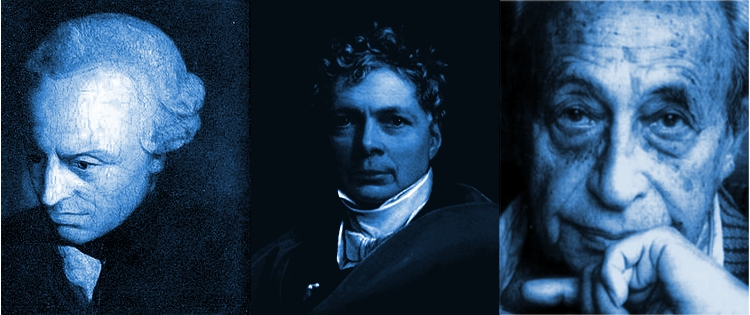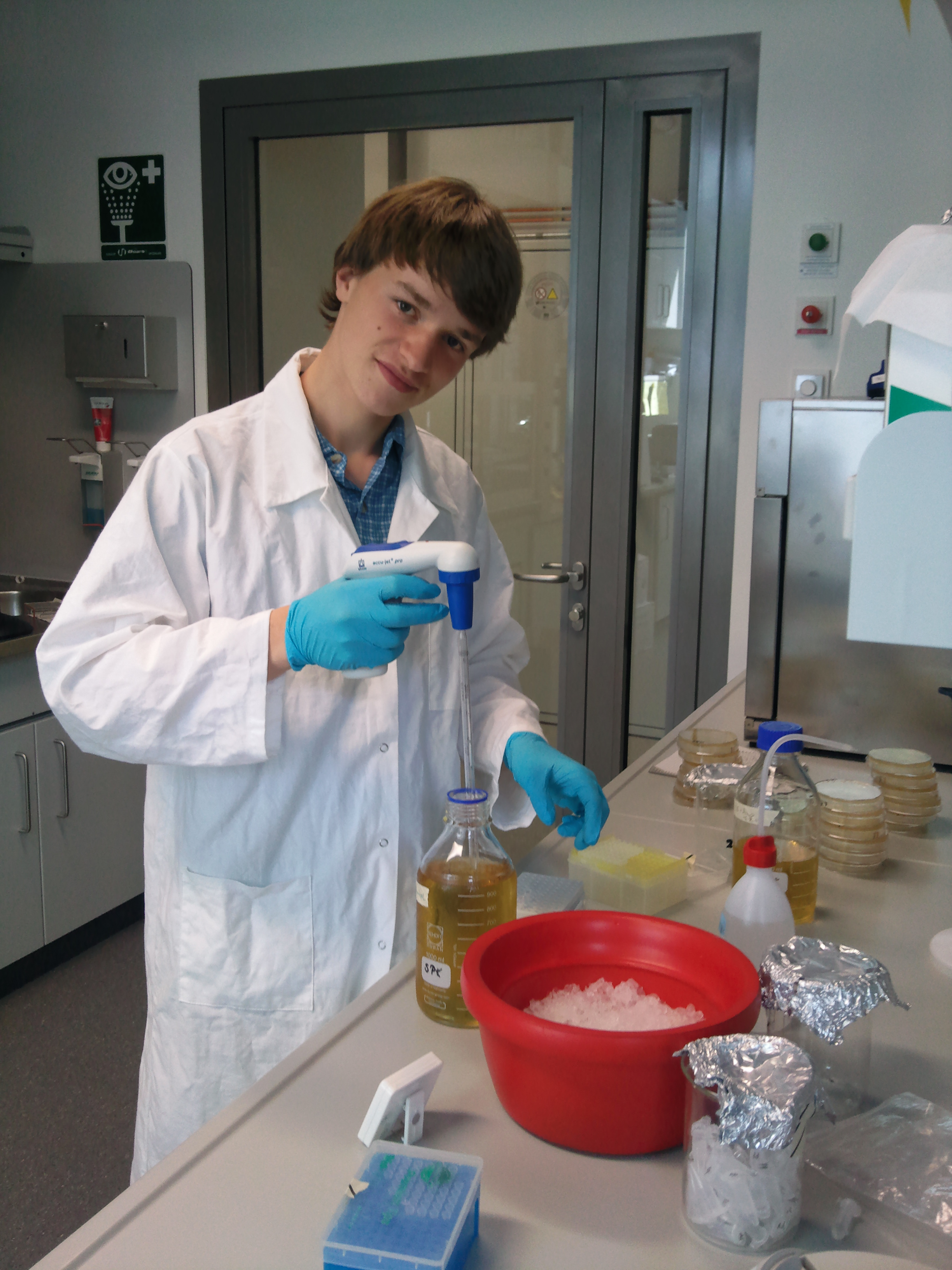Team:Freiburg/HumanPractices/Education
From 2012.igem.org
Pablinitus (Talk | contribs) (→2. EDUCATIONAL OUTREACH) |
Pablinitus (Talk | contribs) (→2.2 High school Students) |
||
| Line 81: | Line 81: | ||
<div style= "font-size: 16px; text-indent:30px"> 2.2.2 Practical training in our lab </div> | <div style= "font-size: 16px; text-indent:30px"> 2.2.2 Practical training in our lab </div> | ||
| - | |||
| - | |||
| - | |||
| - | |||
| - | |||
| + | [[File:HannesÖhm.jpg|right|470x360px]] | ||
In addition to our presentation in the Merian-school and the Freiburg-Seminar, we invited high school student to have a work experience in our lab. We wanted to give them the opportunity get to know how our everydays work in synthetic biology. The students had the possibility to work with us full time a whole week and learn important methods such as PCR, gel electrophoresis and cell transformation. It was an excellent experience for us to teach these fresh minds the methods of molecular life sciences and it was as a matter of fact even helpful for our own project. | In addition to our presentation in the Merian-school and the Freiburg-Seminar, we invited high school student to have a work experience in our lab. We wanted to give them the opportunity get to know how our everydays work in synthetic biology. The students had the possibility to work with us full time a whole week and learn important methods such as PCR, gel electrophoresis and cell transformation. It was an excellent experience for us to teach these fresh minds the methods of molecular life sciences and it was as a matter of fact even helpful for our own project. | ||
Revision as of 17:58, 24 September 2012
2. EDUCATIONAL OUTREACH
2.1 Children – DNA-Extraction
-- Photos: DropboxphotosPics Neuenburg #5 #11 #12 #17 #20 und ‘0josipWissenstage.jpg’ --
We have ‘spread the word’ of synthetic biology among kids at every opportunity. However, because it is sometimes difficult to express the main ideas of such a specific new field like synthetic biology to small children, we decided to not only to speak about it, but to make them experience it! We wanted to give the children a first impression in the tiny, but amazing world of cell biology by learning through the own action. Using a microscope connected to a computer, we showed the children some cells and explained them the general concept of a cell, the smallest unit of life. After looking at the cells through the microscope the children were able to experience genetics. We explained them in easy terms using a plastic model how the DNA is responsible for the correct functioning and welfare of the cell. To make this rather abstract idea graspable for the kids, we showed how to extract DNA from common vegetables. In this way it was possible for them to actually see the mysterious DNA, who constantly works within their own bodies.
In three different occasions we were able to introduce the children in the field of synthetic biology:
It was really nice to observe the exaltation in the faces of the children using the microscope and to see the smiles of them during DNA-extraction. The positive feedbacks we became are a clear indication of the great time the children had.
You can find the instructions for the DNA-extraction in the following link: XXX </br>
2.2 High school Students
-- Photos: Dropbox Photos HumanPractices Schulbesuch 11.5.2012: #1 DSCF2125; #2 DSCF2121; #3 DSCF2120 UND Freiburgseminar: # 4 24.05.12 18 50 09 --
For us iGEM is indeed a great opportunity for working and learning in a lab, but also a good chance to promote and discuss synthetic biology. In this vein, we decided to teach students the basic ideas of synthetic biology and our project in order to inspire them and enhance their motivation for the study of life sciences. Two of our team members visited a biotechnological high school in Freiburg ([http://www.merian-schule.de/index.php/schularten/gymnasien/biotechnologisches-gymnasium-btg Merian-Schule]) and the [http://www.freiburg-seminar.de/ Freiburg-Seminar], a central organization of the city to promote talented students. During our visit we talk about:
- iGEM and our project
- Possibilities of synthetic biology
- Risks, concerns and social implications
The students and teachers were amazed by the bright prospects of synthetic biology, but also concerned about the risks of it. Although our presentation was not able to reply to all questions and concerns, we still evoked lively interest in synthetic biology and promoted further thoughts. We would like to thank the students and teachers for the active listening and animated participation in the discussions!
In addition to our presentation in the Merian-school and the Freiburg-Seminar, we invited high school student to have a work experience in our lab. We wanted to give them the opportunity get to know how our everydays work in synthetic biology. The students had the possibility to work with us full time a whole week and learn important methods such as PCR, gel electrophoresis and cell transformation. It was an excellent experience for us to teach these fresh minds the methods of molecular life sciences and it was as a matter of fact even helpful for our own project.
2.3 Undergraduates – Compact seminar: ‘Theories of the Living’

|
In an interdisciplinary compact course (7th-8th July 2012) of the Albert-Ludwigs-University of Freiburg called ‘Theories of the Living’ (ger. ‘Theorien des Lebendigen’) we invited students from different disciplines to work on the writings of classical philosophers (Immanuel Kant, Friederich W. J. von Schelling and Hans Jonas) regarding their notion of teleology and natural purposes. With this theoretical framework, we inquired the fact that the products of synthetic biology seems to have both, an intrinsic (natural) purposiveness – because they are a good in itself – and a relative (artificial) purposiveness – because they are being used as means to an end. Equally, we examined the relationship of an ‘intrinsic value’ and an ‘instrumental value’ in the products of synthetic biology. It was an extremely interesting and fruitful work, because the novel entities of the synthetic biology present new philosophical challenges, which are really difficult to deal with. The cooperation between philosophy and biology students in this compact course enabled a unique deepening in the heart of these relevant problems.
On this weekend we also had a special lecture called ‘Semantic Fallacies in the Synthetic Biology’ (ger. ‘Semantische Fehlschlüße in der Synthetischen Biologie’), where, besides a philosophical introduction in the synthetic biology, a number of common speech bias regarding the products of this new field were presented. On the whole, the compact course was an intensive working weekend, which transformed a usual university seminar into a really special interdisciplinary event.
Books we worked with:
Kant I (2009 [1790]): Kritik der Urteilskraft. Suhrkamp, Frankfurt a.M. (eng. Critique of Judgement)
Jonas H (1997): Das Prinzip Leben. Suhrkamp, Frankfurt a.M. (eng. The Phenomenon of Life. Towards a Philosophical Biology)
Schelling FWJ (1797): Ideen zu einer Philosophie der Natur als Einleitung in das Studium dieser Wissenschaft. (eng. Ideas for a Philosophy of Nature: as Introduction to the Study of this Science)
 "
"

